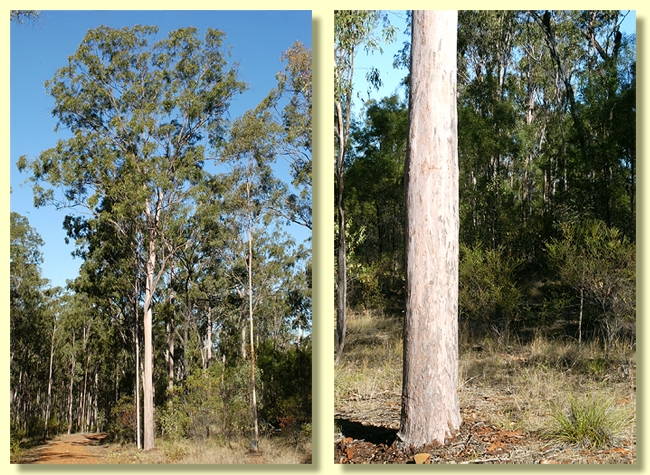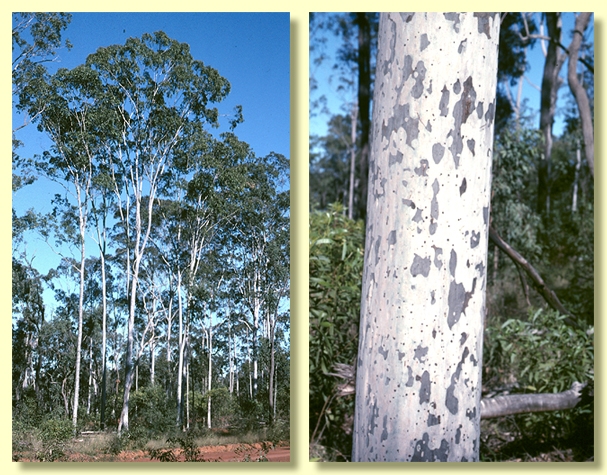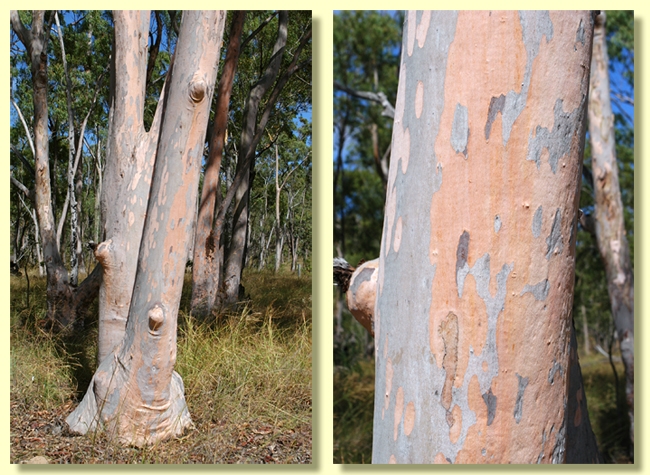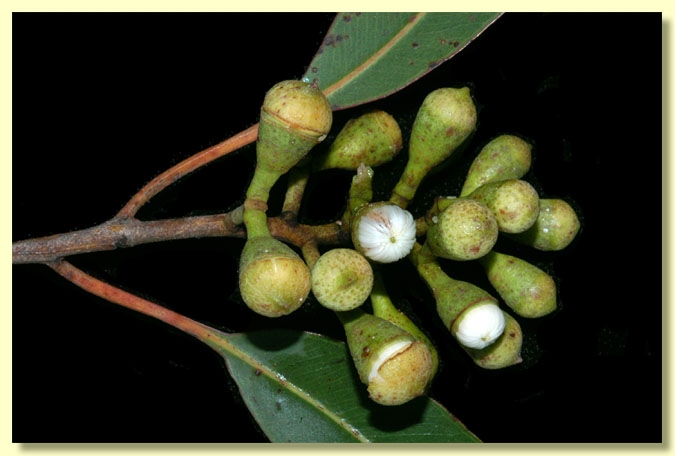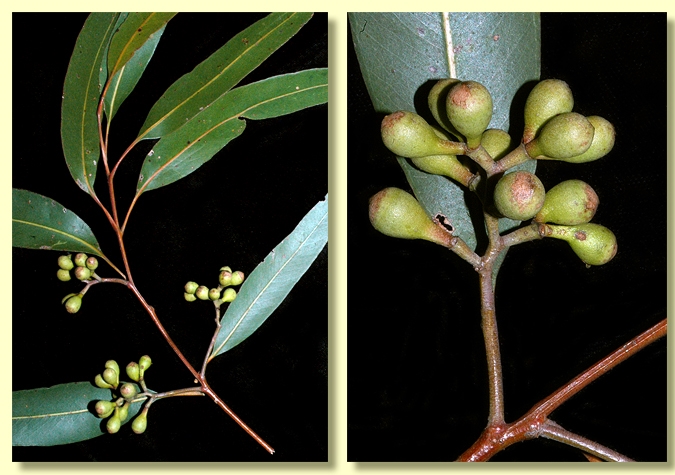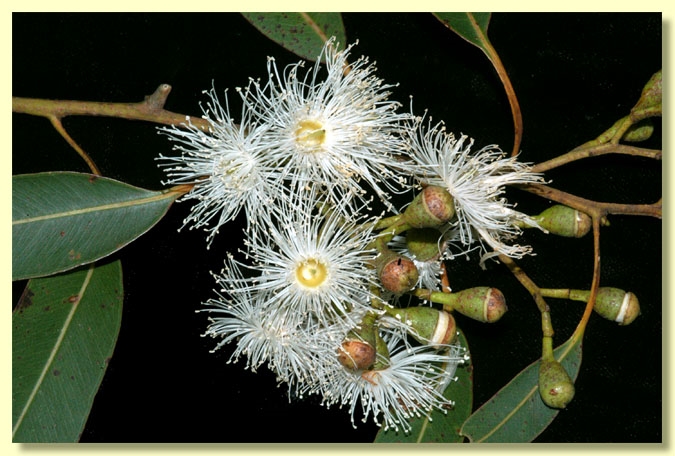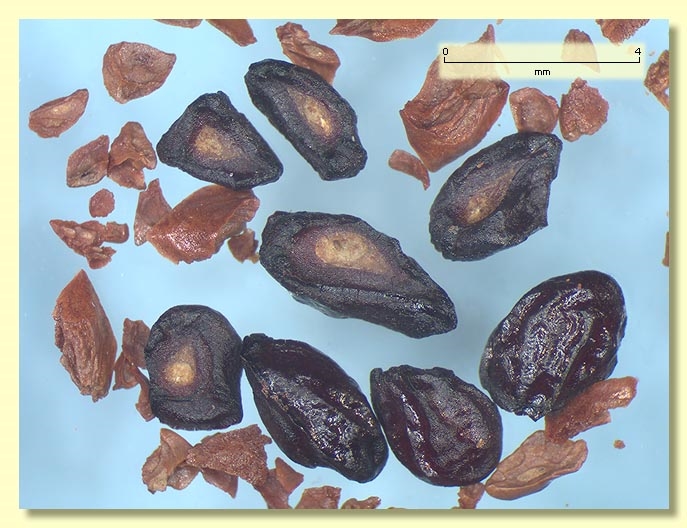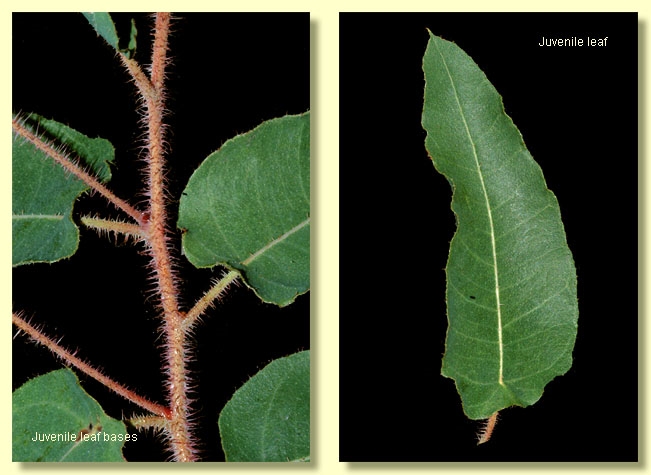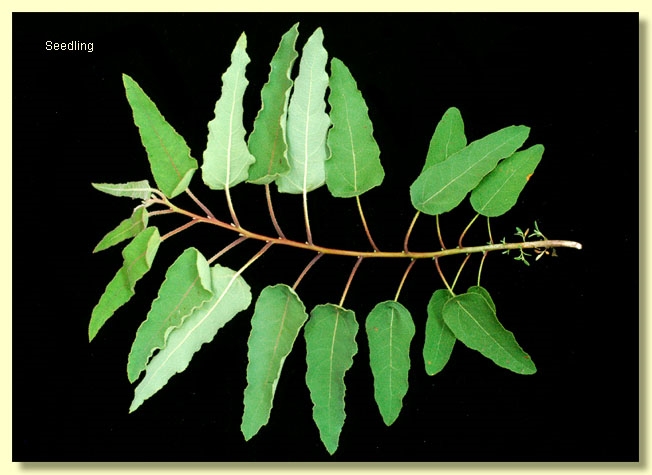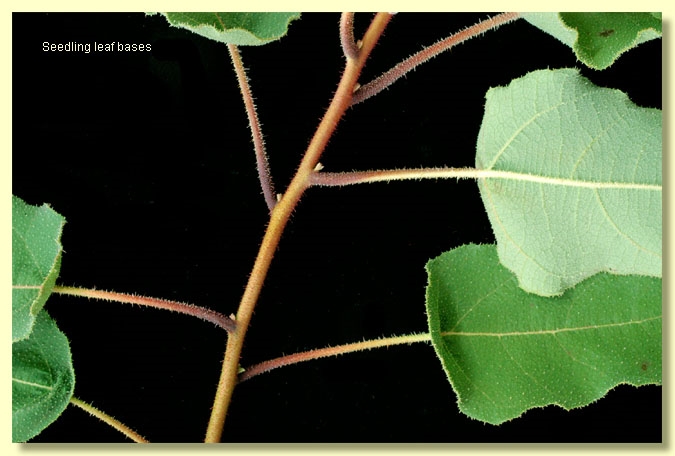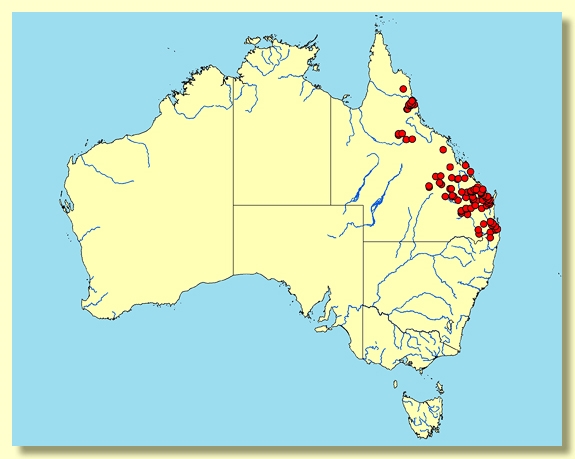Euclid - Online edition
Corymbia citriodora
Corymbia | Politaria
Eucalyptus citriodora Hook. in T.L.Mitchell, J. Exped. Tropical Australia 235 (1848).E. maculata var. citriodora (Hook.) F.M.Bailey, Qld Fl. 2: 634 (1900). E. melissiodora Lindley in T.L.Mitchell, J. Exped. Tropical Australia 235 (1848); T: Queensland: subtrop. New Holland [Balmy Creek], 16 July 1846, T.L.Mitchell 153; holo: K; iso: CGE, MEL.
Eucalyptus maculata var. citriodora F.M.Bailey, Syn. Queensland Fl. 181 (1883), nom. illeg., non (Hook.) F.M.Bailey. T: not designated.
Eucalyptus maculata var. citriodora Kinney, Eucalyptus 89 (1895) nom. illeg., non (Hook.) F.M.Bailey. T: not designated.
Eucalyptus variegata F.Muell., J. Linn. Soc., Bot. 3: 88 (1859); Corymbia variegata (F.Muell.) K.D.Hill & L.A.S.Johnson, Telopea 6: 389 (1995). Corymbia citriodora subsp. variegata (F.Muell.) A.R.Bean & M.W.McDonald, Austrobaileya 5: 735 (2000). T: Queensland, Burnett River, 1856, F.Mueller s.n.; holo: MEL; iso: K.
Bark smooth throughout, white to pink or coppery, often powdery, shedding in thin curling flakes, mottling of trunk often not pronounced.
Juvenile growth (coppice or field seedlings to 50 cm): stem rounded in cross-section, setose to scabrid; juvenile leaves always petiolate, opposite for 2 or 3 pairs then alternate, ovate to lanceolate, 8–21 cm long, 3.2–8 cm wide, the base usually peltate for many nodes, green; petiole and lamina setose to scabrid for many nodes.
Adult leaves alternate, petiole 1–2.5 cm long; blade narrowly lanceolate to falcate, (7)10–23 cm long, 0.6–2.8(3.5) cm wide, base tapering to petiole, concolorous, glossy, green, strongly penniveined, very densely reticulate, intramarginal vein parallel to and just within margin, oil glands island. Leaves lemon-scented when crushed (subsp. citriodora) or not scented (subsp. variegata ).
Inflorescence axillary compound, peduncles 0.3–1 cm long, buds 3 per umbel, pedicels 0.1–0.6 cm long. Mature buds obovoid to pyriform, 0.6–1 cm long, 0.5–0.7 cm wide, green to creamy, usually smooth, scar usually absent (outer operculum held to, or almost to flowering, operculum scar therefore obvious only at late bud development if at all), operculum rounded to conical or slightly beaked, stamens inflexed, anthers cuboid or cuneate, versatile, dorsifixed, dehiscing by longitudinal slits (non-confluent), style long, stigma blunt or mop-like, locules 3, the placentae each with 5 vertical ovule rows (sometimes indistinct). Flowers white.
Fruit pedicellate (pedicels 0.1–0.7 cm long), urceolate or barrel-shaped, 0.8–1.5 cm long, 0.7–1.2 cm wide, disc descending, valves 3, enclosed.
Seeds reddish black, glossy, 2.3–5 mm long, boat-shaped (flattened with a slight dorsal keel), dorsal surface smooth, not winged, hilum ventral.
Cultivated seedlings (measured at ca node 10): cotyledons reniform to orbicular; stems rounded in cross-section, setose/scabrid; leaves always petiolate, the base peltate for at least 15 nodes, opposite for ca 3 pairs then alternating, ovate to lanceolate, 5–15 cm long, 2–8 cm wide, discolorous, dull, green. Leaves setose to scabrid on both sides and on petiole for more than 15 nodes.
Flowering has been recorded in January, April, May, June, July, August, October and December.
Corymbia citriodora is an important forest tree, in demand for structural timber and for honey production. It also is popular in horticulture both within Australia and overseas.
Plants of C. citriodora are naturalised in the Darling Range near Mundaring, Western Australia, also in suburban Sydney, New South Wales and in Victoria e.g. near Puckapunyal, having spread from plantings. Kings Park, Perth, has a famous, beautiful avenue of this species planted many years ago, but it has spread to become a serious weed there also (Hussey et al., 1997).
A tall tree from temperate and tropical eastern Australia, found north from Coffs Harbour, New South Wales, throughout coastal and montane eastern and central Queensland inland to Chinchilla, the Carnarvon Range, Great Dividing Range east of Tambo, west from Townsville to Hughenden, and further north to Cooktown and Lakeland Downs on southern Cape York Peninsula. It prefers lighter loamy soils or skeletal soils and occurs as a component of dry sclerophyll forest and woodlands in hilly country. Corymbia citriodora has smooth, uniform to ± mottled bark whitish to coppery in season, and a conspicuously narrow-leaved crown which, in northern populations, is strongly lemon-scented. Pear-shaped buds are borne in clusters of three aggregated into compound inflorescences in the axils of leaves, whilst fruit are urn-shaped to barrel-shaped and to 0.7–1.2 cm wide and relatively thick-walled. Seeds are flattish and have a median dorsal keel. Juvenile leaves are setose and have peltate leaf bases.
C. citriodora is very similar to C. maculata, differing only in having slightly narrower crown leaves, less mottled bark and juvenile leaves that are still setose to scabrid (feel rough) on comparatively taller coppice growth. In C. maculata foliage is never lemon-scented; the juvenile leaves, whilst scabrid at first, soon become smooth on moderately low regrowth, whilst the bark is spotted due to the irregular pattern of shedding. C. maculata is found from Taree south to Bega in New South Wales and disjunctly in the Mottle Range in eastern Victoria.
C. citriodora and C. maculata both differ from a third species of spotted gum, C. henryi, found from the greater Brisbane area in Queensland to near Grafton in New South Wales. C. henryi, described by Stan Blake in 1977 as Eucalyptus henryi, has generally larger and coarser juvenile and adult leaves and larger buds and fruit, though the ranges in dimensions do overlap. In addition, with C. henryi fewer juvenile leaves have peltate leaf-bases than in both C. citriodora and C. maculata .
In the classification of Brooker (2000) this species, as Eucalyptus citriodora, is placed in Eucalyptus subgenus Corymbia series Maculatae (the spotted gums). In their revision of the bloodwoods and ghost gums, Hill & Johnson (1995) named this species Corymbia citriodora, in genus Corymbia section Politaria (the spotted gums).
Hill & Johnson (ibid., pp. 389–90) segregated another species, C. variegata, from C. citriodora, on the basis of leaves not being lemon-scented, combined with slight differences in juvenile and adult leaf dimensions and a more southerly distribution (from Coffs Harbour, New South Wales north to Maryborough, Carnarvon Range and Chinchilla in Queensland). McDonald & Bean (2000) reduced the status of C. variegata to C. citriodora subsp. variegata, stating that the main difference was the absence of lemon scent in foliage of subsp. variegata. Until quite recently subsp. variegata (as E. variegata F.Muell.) was regarded as belonging to E. maculata (see for example Chippendale (1988), Brooker & Kleinig (1994)). In EUCLID, C. variegata is included within a broader concept of C. citriodora. Further discussion of the taxonomic background can be found in the references cited. The degree of genetic and morphological difference between these spotted gum species and subspecies is slight indeed and is discussed in some detail in the following references: Larmour et al. (2000), Larsen (1965), McDonald et al. (2000).
Historically Mueller (1879, third decade) stated "E. citriodora can only be considered a variety of E. maculata, differing merely in the exquisite lemon-scent of its leaves...", and he included both it and his 1859 species E. variegata in synonymy with the earlier described E. maculata.
In EUCLID we follow Hill & Johnson's view restricting C. maculata to New South Wales and eastern Victoria but treat C. variegata as a synonym of C. citriodora (in effect a citronellal-free chemotype of that species). All spotted gum species are important and well known in forestry and horticulture, and there is considerable merit in recognizing specific distinction between the three core forms C. citriodora, C. maculata and C. henryi.
Botanists who want to go further and distinguish the two chemotypes of C. citriodora and C. maculata may find the following short key useful:
1. Foliage with strong lemon scent, bark mostly not mottled: C. citriodora subsp. citriodora
1a. Foliage not lemon-scented, bark mottled
2. Seedling/juvenile leaves still with peltate leaf-bases at node 10: C. citriodora subsp. variegata
2a. Seedling/juvenile leaves mostly lacking peltate leaf-bases by node 9: C. maculata
MORE ABOUT CORYMBIA
MORE ABOUT SPOTTED GUMS


